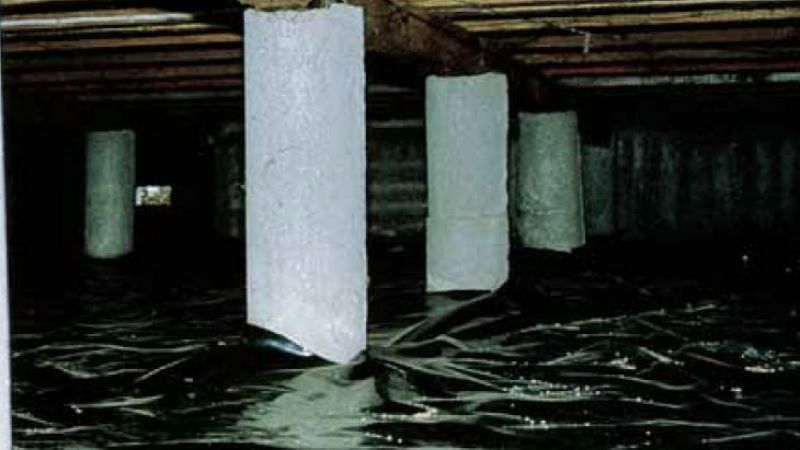
Ground Moisture Barrier

- Product description
- Product details
Why you need Ground Moisture Barrier?
On average 250ml of water evaporates from each 1m² of ground in 24 hours – that’s 60 litres a day for a 150m² house. This moisture getting into your home causes rot, mould, mildew and affecting health.
A great way to reduce moisture levels is to install a ground moisture barrier (also known as on ground vapour barrier). This polythene sheeting will restrict the evaporation of moisture from the ground into the subfloor space. Download our ground moisture barrier factsheet here.
Contact us today for a quote. We can also let you know what payment options are available to pay for your other energy efficient products.
80% off Ground Moisture Barrier.
Some homeowners may also be eligible* for subsidies for ground moisture barrier. If not, we have other finance and payment options available. Get a quote today and we can let you know what you're entitled to.
Installing a vapour barrier, also known as an onground moisture barrier on the ground under your house will keep the moisture in the ground and stops the air under the floor from getting damp.
Ground moisture barrier is 250 micron polythene sheeting that is at least 0.25 mm thick and covers the ground under a house.
For the vapour barrier to be effective, quality installation is key.
• any leaks from water or waste pipes, wet areas, cladding and so on must be dealt with before the moisture barrier is laid
• check there is no surface water flowing under the building – rain should drain away from the house
• the ground under the house should be shaped so no surface water accumulates on top of the vapour barrier
• the vapour barrier should completely cover the soil & be butted up to surrounding foundation walls and piles
• the sheets should be weighted down to avoid being moved by the ventilating air movement
Contact us today for a free measure and quote, and we can install it for you as the same time as your underfloor insulation.
Finance & Funding
New Zealand Bank Green Loan
Find out about 'Green Loans' from New Zealand's major banks of up to $50,000 at 0% interest for 5-years
Warmer Kiwi Home's subsidy grant
Mammoth insulation is an approved product for use in the governments Warmer Kiwi Homes Programme with homeowner grants between 80-100% to retrofit ceiling and underfloor insulation in eligible homes.
6 questions & answers about this product
What is a ground moisture barrier?
A ground moisture barrier (also know as on-ground vapour barrier) is a sheet of polythene that lays over the ground under floors to stop moisture in damp ground evaporating into the home creating damp, unhealthy conditions.
The polythene must be at least 250 microns (or have a vapour flow resistance of at least 50 MN s/g) and must be free of significant tears or holes that would allow moisture through.
Do I need a ground moisture barrier?
If the ground underneath your home is regularly damp you should have a ground moisture barrier laid to avoid "rising damp" which can cause mould and unhealthy damp conditions in your home.
A ground moisture barrier is polythene sheeting which can be installed at the same time as your underfloor insulation.
What ground barrier do rentals need?
Having ground moisture barrier in enclosed sub-floors is a requirement for rental properties under the Healthy Homes Standards.
If more than 50% of the perimeter is enclosed then ground moisture barrier will be needed. This is an effective way to protect your property from moisture damage. You can read more about moisture barrier and moisture ingress on the Tenancy Services Heathy Homes Guidelines for Moisture Ingress.
How do you install ground moisture barrier?
While ground moisture barrier sheets are not expensive, the key is to install it correctly or the benefits of a drier home will not be achieved. A well installed moisture barrier will:
- Completely cover the underfloor area without gaps or rips.
- Will extend at least 50mm up the foundation walls and the piles.
- For sloping sites will have the lowest edge short of the foundation wall to allow run-off.
- The upturns of 50mm around piles will be taped.
- Adjoining sheets will overlap by at least 150mm.
- Overlaps and edges are either weighted down or pinned at 1 meter intervals or less.
Are there subsidies for ground moisture barrier?
If your property is eligible for an EECA insulation subsidy - it will also cover the cost of ground vapour barrier as well.
Is ground moisture barrier required for the Healthy Homes Standards?
Yes. If your rental property has a suspended floor and 50% or more of the sub-floor perimeter is obstructed then a ground moisture barrier is required.
The obstruction could be by walls, dirt, rock, adjoining buildings or any other permanent or semi-permanent structure.
More reading for Ground Moisture Barrier
Let's Chat
We give advice and quotes on a range of products to make your home or investment property warmer, healthier and more energy efficient. Contact our Brightr team who’ll take you through how improving your property can be made easy.
Hate filling in forms? Call us direct 0800 888 766
We answer 24 hours, 7 days a week so call us anytime.
